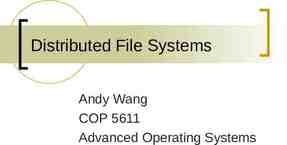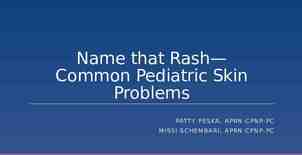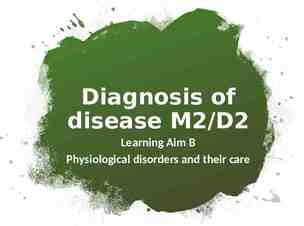Information Management and Technology Strategy 2021-2024
17 Slides9.26 MB
Information Management and Technology Strategy 2021-2024
CONTENTS Foreword 03 Section 1 – Context and Direction Business Context 05 Business Drivers 06 Focus and Challenges 07 Section 2 – Strategic Actions 08 IMT Vision and Mission09 IMT Strategic Goals 2021-2023 10 IMT Contribution to Business Success Section 3 – Governance 12 Guiding Principles 13 IMT Risks and Issues 14 IMT Governance Structure 15 Key Performance Indicators 16 Major Achievements 2017 – 2020 17 Information Management and Technology Strategy 2021-2024 04 11
Foreword I am delighted, as Chief Information Officer for the Department of Agriculture, Food & Marine, to introduce the Department’s new Information Management and Technology Strategy for 20212024. This critical strategy will underpin the Department’s vision of an innovative and sustainable agri-food sector operating to the highest standards through utilising progressive IMT architectures, systems and technologies. It is our mission to provide ICT services which will enable the Department to operate at the highest possible level whilst supporting excellent customer service and the continued implementation of appropriate systems of accountability and controls. While the Department faces significant challenges such as Covid-19, Brexit and trade uncertainty, climate change concerns, and future Common Agriculture Policy and Common Fisheries Policy reform, the Department, and in particular the IMT Group, has many opportunities to develop further and build on current services provided. Following an extensive stakeholder consultation, I am confident that the goals of the IMT Strategy 2021-2024 link closely to the needs of our stakeholders as well as to the Department’s strategic objectives and initiatives. It is acknowledged that the shift to digital services and demand for continuous services has not only grown at an unprecedented rate but is also now driven by external factors creating a demand for 24/7 digital services on multiple platforms. The previous Strategy provided a solid foundation on which we are now in a position to build more agile and robust services which will enable the Department to meet demands over the next three years, whilst continuing to deliver high quality schemes. I would like to acknowledge the successes achieved during the lifetime of the previous IMT Strategy (2017-2020) that delivered considerable improvements in the delivery of services including; the establishment of a Data Analytic unit; enhancements to digital services including the introduction of mobile apps and sensors assisting with the expansion of capabilities of business areas; the introduction of the Customer Relationship Management System that provides a customer centric experience. Value for money was also maximised through the appropriate use of Civil Service Wide ICT Central Services delivered by OGCIO and NSSO; continuous improvements in the area of IT Security and the Enterprise Architecture review which identified key areas for modernisation and growth. Information Management and Technology Strategy 2021-2024 Digital transformation and modernisation of current technologies and skills will be at the forefront of delivering on this Strategy along with its alignment with the strategies and targets set out in the DAFM Statement of Strategy 2021-2024, the Public Service ICT Strategy, OGCIO Strategy, Food Wise 2025, the Programme for Government, National Digital Strategy, Civil service ICT Professionalisation Strategy and the Civil Service Renewal Plan. A key outcome of this Strategy will be the delivery of end to end services by maximising opportunities for technology adoption and innovation with a focus on delivering customer centric services through digitalisation.
Section 1 – Context and Direction Information Management and Technology Strategy 2021-2024
Business Context DAFM VISION A sustainable, innovative and competitive agri-food, forestry and seafood sector DAFM MISSION Lead, enable and regulate the sector in a way that optimises its contribution to social, economic and environmental sustainability DAFM BUSINESS Animal Health and Welfare FoodSafety, Safety, Public Public Health Food Health and Issues andConsumer Consumer Issues Farmer Schemes and Payments Forestry Forestry Sector Farming Sectors Research Research Food Industry Development, Trade, Markets and the Economy Rural Environment and Sustainability Seafood Sector Information Management and Technology Strategy 2021-2024 DAFM STRATEGIC GOALS GOAL 1 To promote and safeguard public, animal and plant health and animal welfare for the benefit of consumers, producers, the economy GOAL 2 and wider society Provide income and targeted supports to farmers and others in the agri-food sector to underpin the rural economy and optimise environmental sustainability GOAL 3 Provide the optimum policy framework for the sustainable development of the agri-food sector GOAL 4 Deliver a sustainable, competitive and innovative seafood sector, driven by a skilled workforce, delivering value added products in line with consumer demand GOAL 5 Maintain and develop strategic, operational, regulatory and technical capacity and capability to deliver excellent services to our customers
Business Drivers Policy Drivers Program for Government DAFM Statement of Strategy 2021-2024 Brexit Changing Markets Transition Period to CAP New Common Agricultural Policy (CAP) New Common Fisheries Policy (CFP) Environmental Drivers Socio-Economic DriversDrivers Socio-Economic Legislative Drivers European Green Deal Climate Change Budget Animal Welfare Food Safety and Emission Targets Animal Health Dietary Change Availability of Skilled Official Controls Support Climate Action, Improve Water Quality & Biodiversity National Environmental Policy Pandemic Disease Incidents Information Management and Technology Strategy 2021-2024 resources Loss of Experienced Staff Changing Work Environments & Practices Economic Environment Remote Working Food Authenticity GDPR OpenData ISO27001 EU & National Regulations Climate Action & Low Carbon Emissions
Focus and Challenges Brexit & International Trade Protecting the EU Single Market and expanding into new international markets is key in supporting the Agri-Food sector in Ireland Global Pandemic The Department continues to respond swiftly and effectively to support the Agrifood industry throughout the Covid-19 crisis Climate Change & Environment Relevant and effective measures will be required to meet the increasing challenges that climate change will bring to the Agrifood Sector. DAFM will prepare & support the sector to meet its climate & environmental change obligations Information Management and Technology Strategy 2021-2024 Changing Work Environments The Department will embrace and enable developments in work environments through changed work practices and technological innovations Animal & Plant Health, Animal Welfare & Food Safety and Food Authenticity DAFM will continue to regulate and enforce and provide guidance and governance in the areas of animal & plant health, animal welfare and food safety and food authenticity New CAP & CFP Programmes Implementation of the new CAP and CFP Programmes will require huge effort across a number of DAFM areas
Section 2 – IMT Strategic Actions Information Management and Technology Strategy 2021-2024
IMT Vision Maximise opportunities for technology adoption and innovation with a focus on delivering customer centric services through IMT digitalisation Mission Provide ICT services to allow the Department to operate at the highest possible level; support excellent customer service and the continued implementation of appropriate systems of accountability and controls Information Management and Technology Strategy 2021-2024
IMT 1 Strategic Goals 20212 2023 Be Digital In meeting the needs of DAFM customers and workforce, IMT will seek to exploit opportunities for digital transformation, to enhance the customer’s user experience and will put in place the appropriate structures to support the agri-food sector and facilitate working in a secure manner from any location Invest in our People We will work with stakeholders (such as the OGCIO) to ensure provision of a highlyskilled, agile workforce committed to providing the technological solutions that will underpin the wide-ranging operations of the Department. We will support the continuing professional development of our IT staff through mentoring, coaching and formal training 3 Be Agile Work in partnership across DAFM to enable the organisation to be more adaptive, creative and resilient in dealing with complexity, uncertainty and change leading to improved outcomes and enabling rapid response to ever changing customer demands 4 Leverage our Data IMT will endeavour, whilst respecting GDPR obligations, to provide high quality information to support evidence-based decision making and accountability 5 Technology – use strategic technologies to evaluate and innovate IMT will continue to identify, source and maximise opportunities offered by innovative technologies capable of meeting current and future business and operational needs of the Department 6 Information Management and Technology Strategy 2021-2024 Improved Governance IMT will ensure that investments are aligned with and delivered in accordance with the Department’s Strategic Objectives by defining organisational structures, processes, roles and responsibilities
IMT Contribution to Business Success 1 . Be Digital 2 . 3 . Invest in our People Continue to build In addition to DAFM recruitment digital services that are customer centric channels, we will collaborate with Focus on a Digital OGCIO and other organisations to Transformation continue to build agenda DAFM IMT capability in line with the Civil Further exploit Service ICT HR opportunities to Professionalisation implement digital Strategy solutions across the wide-ranging scope Review DAFM roles of DAFM business and skill sets on an activities in ongoing basis to alignment with ensure the Public Sector ICT organisation has the Strategies necessary capabilities and resources to meet future challenges Embrace the digitisation of information Information Management and Technology Strategy 2021-2024 Be Agile 4 . Leverage our Data 5 . Technology Ongoing investment Continue to adopt new and innovative in Data Analytics capabilities to technologies that enhance corporate enhance customer decision making experience 6 . Improved Governance Ensure IT investments are aligned with and delivered in Further explore accordance with the Department’s technologies to Enable Technical enhance technical Leverage data to Strategic objectives agility and enable by defining assist in the delivery agility through organisational DAFM to be more of the targets set software efficient and structures, modernisation of out in the dynamic processes, Programme for our existing leadership, roles Government and strategic platforms. and responsibilities Enable access to related agri-food information from Extend adoption of sector strategic anywhere goals Green IT technology Enhance governance to reduce the impact structures across Advance the Ongoing compliance the organisation on the environment embracement of to the relevant EU agile development Monitor adherence and National Data to ensure business related legislations to Information agility and adapt to Security through changing regulations and requirements standards (such as GDPR and ISO 27001 Building Business Information Security NAME OR LOGO Architecture by Standard)
Section 3 – Governance Information Management and Technology Strategy 2021-2024
Guiding Principles 01 Strategic Focus IMT systems development is driven by and aligned to customer expectations and business objectives to deliver the best services 02 Governance and Compliance IMT adheres to best practice governance and Information Security standards 03 Standardis ed Services IMT centrally governs its architecture and development methodologies to ensure maximum efficiency and re-use of assets and take environmental impact into account Information Management and Technology Strategy 2021-2024 04 05 Green IT Creativity IMT will adopt initiatives that reduce energy consumption and manage our environmental technology footprint IMT seeks to use innovative methods and technologies to support business objectives 06 Risk Managem ent IMT manages risk in line with the Department’s Risk Management methodology 07 Value for Money IMT follows OGP and DPER guidance on procurement and finance
RISK IMT Risks and Issues Information Management and Technology Strategy 2021-2024 MITIGATION 1. Dependency on the skills of external contractors to support DAFM’s IMT technologies IMT will invest in staff development in order to meet the Department’s evolving requirements and will operate in line with central Government guidelines in relation to vendor management and competitive procurement procedures 2. Difficulty in attracting suitably qualified resources coupled with loss of experienced DAFM IMT staff due to retirement and promotion may lead to IMT capability issues Identify key roles and skills required, implement targeted recruitment campaigns, implement succession planning and continuous professional development of staff 3. The significant number of staff working remotely and the implications in terms of cyber security and connectivity Provide continual information security awareness to all staff and provide robust and secure remote access solutions 4. IT legacy systems In line with the Enterprise Architecture Modernisation Project IMT will build new systems using innovative technological solutions and agree a migration pathway for the legacy systems 5. IMT’s capacity to maintain and continually improve digital service offerings IMT will collaborate with business stakeholders to provide optimum digital services based on business priorities 6. Risk of cyber attacks/threats IMT will continually review its security measures in line with best practice and increase the Information Security Awareness campaigns 7. Capability of IMT to respond in the event of threats to the Agri-Food industry IMT will put in place scalable and flexible IT solutions which will be digital, agile and readily adapted to meet changing DAFM business requirements
IMT Governance Structure DECISION DOMAIN ACCOUNTABLE RESPONSIBLE IMPLEMENTER INFORMED STRATEGY ITSC* CIO PMO IMT SENIOR MANAGEMENT BUSINESS PROCESSES DAFM SENIOR MANAGEMENT DAFM SENIOR MANAGEMENT IMT STAFF AND SYSTEMS ITSC/MB INVESTMENTS AND BENEFITS MANAGEMENT BOARD CIO CIO AND IMT FINANCE DIVISION DPER/MB ARCHITECTURE CIO ENTERPRISE ARCHITECTURE GROUP IMT TECHNICAL STAFF EXTERNAL EXPERTISE AND ADVICE ITSC/OGCIO RISK IMT SENIOR MANAGEMENT/PROJECT BOARDS PROJECT MANAGER PROJECT TEAMS PROJECT BOARD/MB SOURCING CIO IMT SENIOR MANAGEMENT OGCIO/PAS/HR/IMT ITSC/MB MB/OGCIO CIO Chief Information Officer; MB Management Board; IMT Information Management and Technology; ITSC Information Technology Steering Committee; PMO Programme Management Office; OGCIO Office of the Government Chief Information Officer; PAS Public Appointments Service; HR Human Resources; DPER Department of Public Expenditure & Reform *The Information Technology Steering Committee (ITSC) is a senior management board that approves, monitors and prioritises on-going programmes, takes responsibility for new initiatives, provides insight on long-term strategies and ensures business objectives are being appropriately addressed Information Management and Technology Strategy 2021-2024
Key Performance Indicators 1 . Digital Business 2 . Invest in our People 3 . Be Agile 4 . Leverage our Data The number of IMT roles and skill Accelerate business Establish a sets identified to digital services product corporate-wide offered to our ensure the development and Logical Data customers and staff organisation has the deployment with Warehouse and by exploiting necessary DevSecOps Business capabilities and Innovation Intelligence (BI) Quicker response Technology resources to meet platform future challenges times to delivering Remove all papersystems in times of The utilisation of BI The number of staff crisis (such as, based forms across the recruited from national disease internally to Department to various channels outbreak) increase value add assist with strategic (such as, tasks and provide decision- making Apprenticeship Drive further staff efficiencies for processes Programme, adoption of the Department Internship services-based Continue to leverage Programme and enterprise data (from internal specialised OGCIO architecture and external run ICT campaigns) sources) to assist in Redesign the delivery of the Introduce IMT applications to targets set out in specific staffing create lighter, the Programme for initiatives (such as, flexible and reGovernment and Professional useable systems related agri-food Development and a sector strategic Mentoring Enhance technical goals Information Management and Technology Strategy 2021-2024 Programme) 5 . Technology Continue to adopt new and innovative technologies that are aligned with customer expectations and business requirements 6 . Improved Governance Ongoing adherence to Information Security regulations and standards (such as GDPR and ISO 27001 Information Security Standard) Enhance the Increase adoption of governance Green IT technology processes to ensure and avail of cloudICT investments are based solutions (in aligned with line with OGCIO business priorities guidelines) NAME OR LOGO
Major Achievements 20172020 32 Million Forestry Premium Applications Animal Movements Digitally tracked 2019-2020 Forestry Online Licence Viewer launched in 2020 online 100% Animal Online Registration Tags issued 2019-2020 24,500 Farmers paid 41 Million 9.8 Million Over 54,000 1.6 Billion Forestry Premium Applicants 300,000 Annual Agri-Scheme Payments Sheep Welfare 16 Million Fisheries Declarations digitally processed annually BDGP I & II 2020 Fish Quotas digitally managed annually 196,060 tonnes 22,400 Farmers paid 37.3 Million Paid to over 18,000 Farmers Webinars Hosted 2020 7 other Govt Depts and Agencies paid to 192 DAFM provides ICT Shared Services for ICT capability implemented for full Remote Working experience 252 Million SMS issued by DAFM to registered customers WebEx Meetings Online Animal Disease Tests Performed BEEP 2020 2019-2020 Fishing Vessel Positions Tracked 20192020 All major DAFM Schemes now 100% 12.8 Million 13 Million Over 40,000 Data Analytics Unit Created 16,130 Registrants 122 Open Datasets published with over New CRM System implemente d to manage Customer’s Interactions Enterprise Architecture Group Established 10,00 0 views Excess 1.5 Million LPIS Parcels covering over 5.6 Million Ha 19 Open Datasets published on datacatalogue.gov. ie Data Sharing with Public Sector bodies and EU Mobile Applications incl. Calf Registration App implemented Cyber Security Unit Created






















